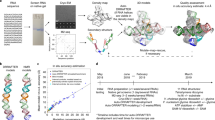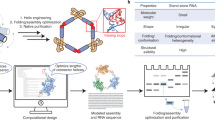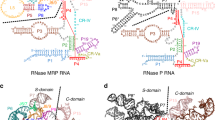Abstract
Increasingly, cryo-electron microscopy (cryo-EM) is used to determine the structures of RNA–protein assemblies, but nearly all maps determined with this method have biologically important regions where the local resolution does not permit RNA coordinate tracing. To address these omissions, we present de novo ribonucleoprotein modeling in real space through assembly of fragments together with experimental density in Rosetta (DRRAFTER). We show that DRRAFTER recovers near-native models for a diverse benchmark set of RNA–protein complexes including the spliceosome, mitochondrial ribosome, and CRISPR–Cas9–sgRNA complexes; rigorous blind tests include yeast U1 snRNP and spliceosomal P complex maps. Additionally, to aid in model interpretation, we present a method for reliable in situ estimation of DRRAFTER model accuracy. Finally, we apply DRRAFTER to recently determined maps of telomerase, the HIV-1 reverse transcriptase initiation complex, and the packaged MS2 genome, demonstrating the acceleration of accurate model building in challenging cases.
This is a preview of subscription content, access via your institution
Access options
Access Nature and 54 other Nature Portfolio journals
Get Nature+, our best-value online-access subscription
$29.99 / 30 days
cancel any time
Subscribe to this journal
Receive 12 print issues and online access
$259.00 per year
only $21.58 per issue
Buy this article
- Purchase on Springer Link
- Instant access to full article PDF
Prices may be subject to local taxes which are calculated during checkout





Similar content being viewed by others
Data availability
The accession codes used in this study are as follows: E. coli L25-5S rRNA (PDB 1DFU and 1B75), sex-lethal RRM (PDB 1B7F and 3SXL), ribotoxin restrictocin sarcin-ricin loop analog (PDB 1JBS and 1AQZ), the SmpB–tmRNA complex (PDB 1P6V and 1K8H), the HutP antitermination complex (PDB 1WPU and 1WPV), the mRNA-binding domain of the SelB elongation factor (PDB 1WSU and 1LVA), the NusA transcriptional regulator (PDB 2ASB and 1K0R), the methyltransferase RumA in complex with rRNA (PDB 2BH2 and 1UWV), the PP7 coat protein and viral RNA (PDB 2QUX and 2QUD), Puf4 bound to the 3′ UTR of the target transcript (PDB 3BX2 and 3BWT), tri-snRNP (EMD-2966 and EMD-8012; PDB 4YHU and 5GAN, in addition to all PDB codes listed in Extended Data Table 1 of ref. 9), the mitochondrial ribosome (EMD-2490 and EMD-2787; PDB 4CE4, 4V19, and 4V1A), CRISPR–Cas9–sgRNA complex (EMD-3276; PDB 5F9R and 4ZT0), U1 snRNP (EMD-8622; PDB 3CW1, 3PGW, 5GMK and 5UZ5), the spliceosomal P complex (PDB 5MQ0, 5WSG, 5I8Q and 6BK8), HIV-1 RTIC (described in ref. 44), and Tetrahymena telomerase (EMD-6443; PDB 5KMZ, 2VOP, 5C9H, 2M21 and 4ERD), MS2 packaged genome (EMD-8397 and EMD-3403; PDB 5TC1). The DRRAFTER models of the U1 snRNP (from the 3.6 Å map) and the packaged MS2 genome (from the 3.6 Å map) are available in Supplementary Data 1 and 2. DRRAFTER models for all other systems are available at https://purl.stanford.edu/jj049gk5411.
References
Fica, S. M. & Nagai, K. Cryo-electron microscopy snapshots of the spliceosome: structural insights into a dynamic ribonucleoprotein machine. Nat. Struct. Mol. Biol. 24, 791–799 (2017).
Feigon, J., Chan, H. & Jiang, J. S. Integrative structural biology of Tetrahymena telomerase – insights into catalytic mechanism and interaction at telomeres. FEBS J. 283, 2044–2050 (2016).
Jiang, F. G. & Doudna, J. A. The structural biology of CRISPR-Cas systems. Curr. Opin. Struct. Biol. 30, 100–111 (2015).
von Loeffelholz, O. et al. Focused classification and refinement in high-resolution cryo-EM structural analysis of ribosome complexes. Curr. Opin. Struct. Biol. 46, 140–148 (2017).
Zhou, Z. H. Atomic resolution cryo electron microscopy of macromolecular complexes. Adv. Protein Chem. Struct. Biol. 82, 1–35 (2011).
Leschziner, A. E. & Nogales, E. Visualizing flexibility at molecular resolution: analysis of heterogeneity in single-particle electron microscopy reconstructions. Annu. Rev. Biophys. Biomol. Struct. 36, 43–62 (2007).
Kucukelbir, A., Sigworth, F. J. & Tagare, H. D. Quantifying the local resolution of cryo-EMEM density maps. Nat. Methods 11, 63–65 (2014).
Frank, J. Single-particle imaging of macromolecules by cryo-electron microscopy. Annu. Rev. Biophys. Biomol. Struct. 31, 303–319 (2002).
Nguyen, T. H. D. et al. The architecture of the spliceosomal U4/U6.U5 tri-snRNP. Nature 523, 47–52 (2015).
Greber, B. J. et al. Architecture of the large subunit of the mammalian mitochondrial ribosome. Nature 505, 515–519 (2014).
Chaker-Margot, M. et al. Architecture of the yeast small subunit processome. Science 355, eaal1880 (2017).
Li, X. J. et al. Structure of ribosomal silencing factor bound to Mycobacterium tuberculosis ribosome. Structure 23, 1858–1865 (2015).
DiMaio, F. & Chiu, W. Tools for model building and optimization into near-atomic resolution electron cryo-microscopy density maps. Methods Enzymol. 579, 255–276 (2016).
Brown, A. et al. Tools for macromolecular model building and refinement into electron cryo-microscopy reconstructions. Acta Crystallogr. D Biol. Crystallogr. 71, 136–153 (2015).
Frenz, B. et al. RosettaES: a sampling strategy enabling automated interpretation of difficult cryo-EM maps. Nat. Methods 14, 797–800 (2017).
Kim, D. N. and K. Y. Sanbonmatsu, Tools for the cryo-EM gold rush: going from the cryo-EM map to the atomistic model. Biosci Rep. 37, BSR20170072 (2017).
Wang, R. Y. R. et al. Automated structure refinement of macromolecular assemblies from cryo-EM maps using Rosetta. Elife 5, e17219 (2016).
Dawson, W. K. & Bujnicki, J. M. Computational modeling of RNA 3D structures and interactions. Curr. Opin. Struct. Biol. 37, 22–28 (2016).
Cowtan, K. Automated nucleic acid chain tracing in real time. IUCrJ 1, 387–392 (2014).
Chou, F. C. et al. Correcting pervasive errors in RNA crystallography through enumerative structure prediction. Nat. Methods 10, 74–76 (2013).
Adams, P. D. et al. PHENIX: a comprehensive Python-based system for macromolecular structure solution. Acta Crystallogr. D Biol. Crystallogr. 66, 213–221 (2010).
Keating, K. S. & Pyle, A. M. Semiautomated model building for RNA crystallography using a directed rotameric approach. Proc. Natl Acad. Sci. USA 107, 8177–8182 (2010).
Wang, X. Y. et al. RNABC: forward kinematics to reduce all-atom steric clashes in RNA backbone. J. Math. Biol. 56, 253–278 (2008).
Trabuco, L. G. et al. Flexible fitting of atomic structures into electron microscopy maps using molecular dynamics. Structure 16, 673–683 (2008).
Lu, M. & Steitz, T. A. Structure of Escherichia coli ribosomal protein L25 complexed with a 5S rRNA fragment at 1.8-angstrom resolution. Proc. Natl Acad. Sci. USA 97, 2023–2028 (2000).
Handa, N. et al. Structural basis for recognition of the tra mRNA precursor by the sex-lethal protein. Nature 398, 579–585 (1999).
Yang, X. J. et al. Crystal structures of restrictocin-inhibitor complexes with implications for RNA recognition and base flipping. Nat. Struct. Biol. 8, 968–973 (2001).
Gutmann, S. et al. Crystal structure of the transfer-RNA domain of transfer-messenger RNA in complex with SmpB. Nature 424, 699–703 (2003).
Kumarevel, T., Mizuno, H. & Kumar, P. K. Structural basis of HutP-mediated anti-termination and roles of the Mg2+ ion and L-histidine ligand. Nature 434, 183–191 (2005).
Yoshizawa, S. et al. Structural basis for mRNA recognition by elongation factor SelB. Nat. Struct. Mol. Biol. 12, 198–203 (2005).
Beuth, B. et al. Structure of a Mycobacterium tuberculosis NusA-RNA complex. EMBO J. 24, 3576–3587 (2005).
Lee, T. T., Agarwalla, S. & Stroud, R. M. A unique RNA fold in the RumA-RNA-Cofactor ternary complex contributes to substrate selectivity and enzymatic function. Cell 120, 599–611 (2005).
Chao, J. A. et al. Structural basis for the coevolution of a viral RNA-protein complex. Nat. Struct. Mol. Biol. 15, 103–105 (2008).
Miller, M. T., Higgin, J. J. & Hall, T. M. T. Basis of altered RNA-binding specificity by PUF proteins revealed by crystal structures of yeast Puf4p. Nat. Struct. Mol. Biol. 15, 397–402 (2008).
Nguyen, T. H. D. et al. Cryo-EM structure of the yeast U4/U6.U5 tri-snRNP at 3.7 angstrom resolution. Nature 530, 298–302 (2016).
Jiang, F. G. et al. Structures of a CRISPR-Cas9 R-loop complex primed for DNA cleavage. Science 351, 867–871 (2016).
Jiang, F. G. et al. A Cas9-guide RNA complex preorganized for target DNA recognition. Science 348, 1477–1481 (2015).
Greber, B. J. et al. The complete structure of the large subunit of the mammalian mitochondrial ribosome. Nature 515, 283–286 (2014).
Li, X. N. et al. CryoEM structure of Saccharomyces cerevisiae U1 snRNP offers insight into alternative splicing. Nat. Commun. 8, 1035 (2017).
Liu, S. et al. Structure of the yeast spliceosomal postcatalytic P complex. Science 358, 1278–1283 (2017).
Yan, C. Y. et al. Structure of a yeast step II catalytically activated spliceosome. Science 355, 149–155 (2017).
Fica, S. M. et al. Structure of a spliceosome remodelled for exon ligation. Nature 542, 377–380 (2017).
Jiang, J. S. et al. Structure of Tetrahymena telomerase reveals previously unknown subunits, functions, and interactions. Science 350, aab4070 (2015).
Larsen, K. P. et al. Architecture of an HIV-1 reverse transcriptase initiation complex. Nature 557, 118–122 (2018).
Jiang, J. et al. Structure of Telomerase with telomeric DNA. Cell 173, 1179–1190 (2018).
Dai, X. H. et al. In situ structures of the genome and genome-delivery apparatus in a single-stranded RNA virus. Nature 541, 112–116 (2017).
Koning, R. I. et al. Asymmetric cryo-EM reconstruction of phage MS2 reveals genome structure in situ. Nat. Commun. 7, 12524 (2016).
Cheng, C. Y. et al. RNA structure inference through chemical mapping after accidental or intentional mutations. Proc. Natl Acad. Sci. USA 114, 9876–9881 (2017).
Chou, F. C. et al. RNA structure refinement using the ERRASER-Phenix pipeline. Methods Mol. Biol. 1320, 269–282 (2016).
Kapral, G. J. et al. New tools provide a second look at HDV ribozyme structure, dynamics and cleavage. Nucleic Acids Res. 42, 12833–12846 (2014).
Pettersen, E. F. et al. UCSF chimera—a visualization system for exploratory research and analysis. J. Comput. Chem. 25, 1605–1612 (2004).
Leaver-Fay, A. et al. ROSETTA3: an object-oriented software suite for the simulation and design of macromolecules. Methods Enzymol. 487, 545–574 (2011).
Das, R., Karanicolas, J. & Baker, D. Atomic accuracy in predicting and designing noncanonical RNA structure. Nat. Methods 7, 291–294 (2010).
Kappel, K. & Das, R. Sampling native-like structures of RNA-protein complexes through Rosetta folding and docking. bioRxiv, Preprint at https://www.biorxiv.org/content/early/2018/06/05/339374 (2018).
DiMaio, F. et al. Refinement of protein structures into low-resolution density maps using Rosetta. J. Mol. Biol. 392, 181–190 (2009).
Alford, R. F., et al. The Rosetta all-atom energy function for macromolecular modeling and design. J. Chem. Theory Comput. 13, 3031–3048 (2017).
Perez-Cano, L. & Fernandez-Recio, J. Optimal protein-RNA area, OPRA: a propensity-based method to identify RNA-binding sites on proteins. Proteins 78, 25–35 (2010).
Wriggers, W., Milligan, R. A. & McCammon, J. A. Situs: a package for docking crystal structures into low-resolution maps from electron microscopy. J. Struct. Biol. 125, 185–195 (1999).
Liu, S. et al. A composite double-/single-stranded RNA-binding region in protein Prp3 supports tri-snRNP stability and splicing. eLife 4, e07320 (2015).
Noeske, J. et al. High-resolution structure of the Escherichia coli ribosome. Nat. Struct. Mol. Biol. 22, 336–341 (2015).
Weber, G. et al. Functional organization of the Sm core in the crystal structure of human U1 snRNP. EMBO J. 29, 4172–4184 (2010).
Krummel, D. A. P. et al. Crystal structure of a ten-subunit human spliceosomal U1 snRNP at 5.5 angstrom resolution. Biophys. J. 100, 198–198 (2011).
Wan, R. X. et al. Structure of a yeast catalytic step I spliceosome at 3.4 angstrom resolution. Science 353, 895–904 (2016).
Eswar, N. et al. Comparative protein structure modeling using Modeller. Curr. Protoc. Bioinformatics 15, 5.6.1–5.6.30 (2006).
Kretzner, L., Krol, A. & Rosbash, M. Saccharomyces cerevisiae U1 small nuclear-RNA secondary structure contains both universal and yeast-specific domains. Proc. Natl Acad. Sci. USA 87, 851–855 (1990).
He, Y. Z. et al. Structure of the DEAH/RHA ATPase Prp43p bound to RNA implicates a pair of hairpins and motif Va in translocation along RNA. RNA 23, 1110–1124 (2017).
Kotik-Kogan, O. et al. Structural analysis reveals conformational plasticity in the recognition of RNA 3´ ends by the human La protein. Structure 16, 852–862 (2008).
Jansson, L. I. et al. Structural basis of template-boundary definition in Tetrahymena telomerase. Nat. Struct. Mol. Biol. 22, 883–888 (2015).
Richards, R. J. et al. Structural study of elements of Tetrahymena telomerase RNA stem-loop IV domain important for function. RNA 12, 1475–1485 (2006).
Singh, M. et al. Structural basis for telomerase RNA recognition and RNP assembly by the holoenzyme La family protein p65. Mol. Cell 47, 16–26 (2012).
Acknowledgements
We thank members of the Das lab for useful discussions and members of the Rosetta community for discussions and code sharing. We thank J. Feigon and her lab for sharing their coordinates for the 8.9 Å Tetrahymena telomerase cryo-EM structure. Calculations were performed on the Stanford Sherlock cluster and Stanford BioX3 cluster, supported by NIH Shared Instrumentation Grant 1S10RR02664701. This work was supported by a Gabilan Stanford Graduate Fellowship (K.K.), the National Science Foundation (GRFP to K.K.), and the National Institutes of Health through awards T32 GM008294 (K.P.L. and K.K.), NIGMS R35 GM122579 (R.D.), R21 CA121487 (R.D.), R01 GM121487 (R.D. and P. Bradley), R01 GM114178 (R.Z.), R01 GM126157 (R.Z.), and R01 GM071940 (Z.H.Z.).
Author information
Authors and Affiliations
Contributions
K.K. and R.D. designed the computational approach. K.K. implemented the method and performed the tests and analysis. S.L., Z.H.Z., and R.Z. provided the U1 snRNP and P complex blind test cases. K.P.L., G.S., E.V.P., and J.D.P. provided the HIV-1 RTIC test case and provided initial feedback on the method. K.K. and R.D. wrote the manuscript with input from S.L., K.P.L., G.S., E.V.P., J.D.P., Z.H.Z., and R.Z.
Corresponding author
Ethics declarations
Competing Interests
The authors declare no competing interests.
Additional information
Publisher’s note: Springer Nature remains neutral with regard to jurisdictional claims in published maps and institutional affiliations.
Integrated supplementary information
Supplementary Figure 1 DRRAFTER models for ten small RNA–protein systems.
a–j, The best RMSD DRRAFTER models of the top ten scoring (RNA colored red, protein colored gray) overlaid with the deposited crystallographic coordinates (RNA colored cyan, protein colored gray) shown for a, 3 Å (left), 5 Å (middle), and 7 Å (right) simulated density maps for E. coli L25-5S rRNA (1dfu), b, sex-lethal RRM (1b7f), c, ribotoxin restrictocin sarcin-ricin loop analog (1jbs), d, SmpB–tmRNA complex (1p6v), e, HutP antitermination complex (1wpu), f, the mRNA-binding domain of the SelB elongation factor (1wsu), g, the NusA transcriptional regulator (2asb), h, the methyltransferase RumA in complex with rRNA (2bh2), i, the PP7 coat protein and viral RNA (2qux), and j, Puf4 bound to the 3′ UTR of target transcript (3bx2).
Supplementary Figure 2 Convergence of DRRAFTER models.
a–l, High-resolution RNA coordinates (cyan, left) and the top ten scoring DRRAFTER models (red, right) for the a, spliceosomal tri-snRNP U4/U6 three-way junction, b, U5 three-way junction, and c, U5 internal loop II; d, the CRISPR–Cas9–sgRNA complex sgRNA residues 11–30 and 57–68 and e, sgRNA residues 69–99; f, mitoribosome loop 1 and g, loop 2; h, yeast U1 snRNP (blind) core four-way junction, i, yeast three-way junction, j, SL2-2, and k, yeast four-way junction (DRRAFTER models of SL3-2, SL3-3, and SL3–5 colored red; DRRAFTER models of SL3–4 colored white); and l, yeast spliceosomal P complex (blind) ligated exon.
Supplementary Figure 3 Assessing the agreement between DRRAFTER models and the lower-resolution density maps versus the agreement of high-resolution coordinates to the same lower-resolution density maps.
Real-space correlation coefficients for the best RMSD DRRAFTER models out of the top ten scoring for all systems described in Supplementary Table 1 to lower-resolution density maps are plotted against correlation coefficient values for the corresponding high-resolution coordinates to the same lower-resolution density maps (see Methods for details).
Supplementary Figure 4 Comparing the accuracy of DRRAFTER models to manual models built into the lower-resolution mitoribosome map.
DRRAFTER models were built for all regions in the mitoribosome for which manual models were previously deposited. The accuracy of the manual (previously deposited) and DRRAFTER models was determined by comparing to the higher-resolution mitoribosome coordinates.
Supplementary Figure 5 Differences between the 3.6 Å and 10.5 Å maps of the packaged MS2 genome.
a, The model of region S9 (S9-1 and S9-2) (blue) built into the 3.6 Å map (blue, transparent). b, The model of region S9 (gray) built into the 10.5 Å map (gray, transparent). Each of the models fits well in the map in which it was built. There are, however, differences between the two models. c, Models built into the 3.6 Å and 10.5 Å maps overlaid. These differences are largely due to the underlying differences in the maps. d, The 3.6 Å (blue) and 10.5 Å (gray) maps overlaid.
Supplementary information
Supplementary Text and Figures
Supplementary Figures 1–5 and Supplementary Tables 1–4
Supplementary Data 1
U1 snRNP model
Supplementary Data 2
MS2 packaged genome model
Rights and permissions
About this article
Cite this article
Kappel, K., Liu, S., Larsen, K.P. et al. De novo computational RNA modeling into cryo-EM maps of large ribonucleoprotein complexes. Nat Methods 15, 947–954 (2018). https://doi.org/10.1038/s41592-018-0172-2
Received:
Accepted:
Published:
Issue Date:
DOI: https://doi.org/10.1038/s41592-018-0172-2
This article is cited by
-
Structural basis of Acinetobacter type IV pili targeting by an RNA virus
Nature Communications (2024)
-
All-atom RNA structure determination from cryo-EM maps
Nature Biotechnology (2024)
-
StarMap: a user-friendly workflow for Rosetta-driven molecular structure refinement
Nature Protocols (2023)
-
Structure, folding and flexibility of co-transcriptional RNA origami
Nature Nanotechnology (2023)
-
Snapshots of the second-step self-splicing of Tetrahymena ribozyme revealed by cryo-EM
Nature Communications (2023)



